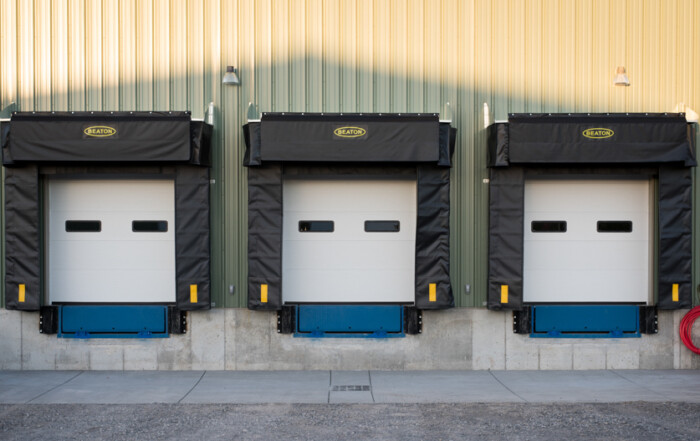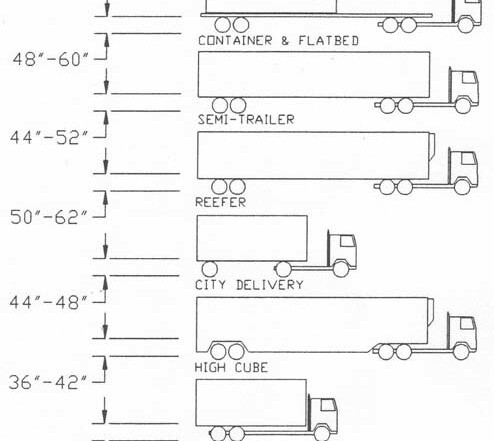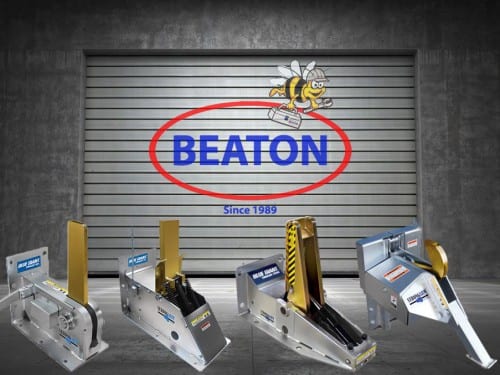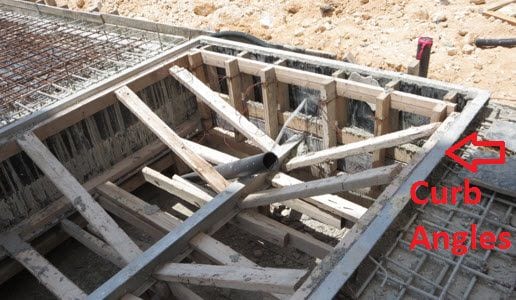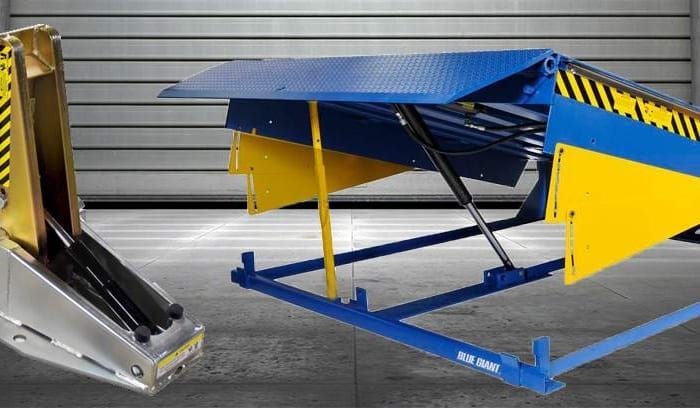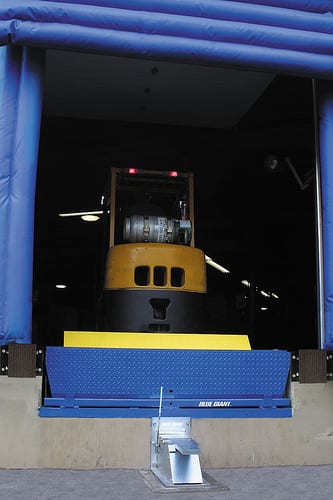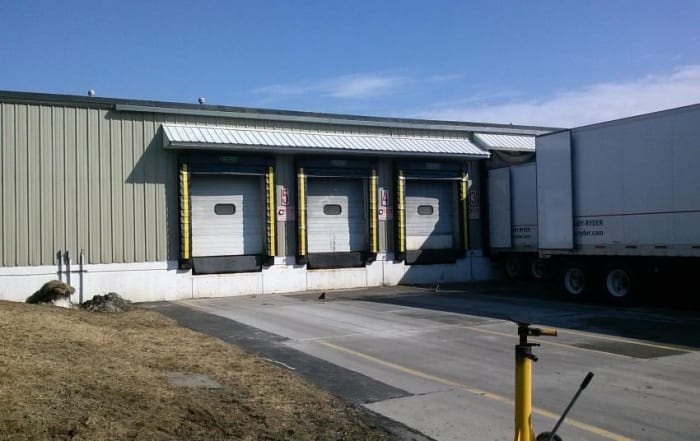Elements of Loading Dock Design

The proficient stream of products in and out of facilities is vital in today’s extremely competitive world. Special consideration must be given to the loading dock area design for this to happen. When coordinating dock heights and door sizes, and when selecting the proper loading dock equipment, there are a number of factors that must be carefully considered.
 Loading Dock Access – Loading Dock Planning and Design
Loading Dock Access – Loading Dock Planning and Design
The Following information is a guideline for applying truck service to the loading dock area to insure proper design, safety and service to your loading dock area. Apply proper Traffic Engineering design standards and compliance with local codes.
Property Gates
Suggested minimum width at gates leading into approach roadways is 16′ to 20′ for one-way traffic, 30′ to 32′ for two-way traffic, and 38′ if pedestrian walkway is to be included.
Roadway Approach
Trucks should be permitted to drive in rather than back in. Straight-through, “Y” or angle approaches should be considered depending on traffic volume estimates.
If mixed passenger car and pedestrian traffic is involved in the approach, suitable separation and safety precautions should be planned for.
Yard Approach
Service roads for one-way truck traffic should be a minimum of 14′ wide… for two-way traffic no less than 26′ wide. If pedestrians are to be accommodated, there should be an additional 6′ lane separated from the roadway by a physical barrier.
If a right angle intersection is required, a 50′ radius should be planned for commercial vehicles.
The design of approach roadways should also allow for counterclockwise traffic circulation since it is easier for drivers to make left-hand turns and to back trailers into a dock from this position.* NOTE: Traffic directions and illustrations on this website are based on trucks with left-hand drive.
Apron Space
The configuration of the area required to maneuver and position trailers into place is called the apron space. Planning apron space requires recognizing trailer movement and the amount of room it takes to achieve that movement.
Traffic flow and vehicle length are key factors for consideration (i.e. a truck with an overall length of 65′ requires a minimum apron space of 135′).
Landing Strip
If the area is to be surfaced with asphalt, a concrete landing strip must be poured. In warm temperatures, the landing strip will prevent the trailer’s landing gear from sinking into the asphalt when spotted. Typical position of semi-truck landing gear is 120″ behind the nose of the trailer. Gravel-covered apron space should be avoided because it creates uneven, unsafe conditions.
Waiting Area
Unless docks are designed to handle peak loads, provision must be made for a truck waiting area. This should be placed so that the trucks in this area do not interfere with trucks maneuvering into or pulling away from the dock.
Pavement Surfaces
These surfaces should be specified to be evenly laid and structurally sound to support heavy wheel loads. All roadway surfaces should be slightly crowned and properly equipped with drainage outlets.
____________________________________________________________________________________________
Loading Dock Type
 Flush Loading Dock Design
Flush Loading Dock Design
Flush docks are in most common use today. Here the face of the dock (foundation) is flush with the outside wall of the building. To prevent wall damage and protect dock seals (if used) on a level approach it is recommended that the foundation/dock bumper extend 4″ beyond the outside wall.
NOTE: If building wall projects beyond the dock face additional foundation/bumper projection is required.
Enclosed Loading Dock
Enclosed docks are generally used when climate control, product protection, security, and overhead lift capabilities are required.
They are not a common choice due to high construction costs and vehicle exhaust pollution considerations.
Open Loading Dock
Open docks, although they may be a necessary alternative in some cases, are not generally recommended because of their weather exposure and susceptibility to pilferage. In all cases these docks should be provided with a canopy. And in situations where canopies are planned over docks on sloped grades, the height of the canopy must be calculated to accommodate the height of the sloped trailer.
Depressed Loading Dock – a.k.a. Declined Approach
Depressed docks with slope driveways are used where building construction eliminates basements and dock level floors. Caution must be exercised in planning the grade of the driveway. It should not exceed 10% in order that the top of the truck will not hit the wall of the building, cargo topple, or that pull-away traction problems result in ice or snow conditions.
Saw Tooth Loading Dock
Saw tooth docks present a design solution to situations where apron space is limited, however they reduce useable dock space.
Additional Loading Dock Articles
Loading Dock Equipment in Norwich, NY
Loading Dock Equipment in Norwich, NY In the bustling industrial and commercial landscape of Norwich, NY, loading dock equipment plays a critical role in ensuring the smooth operation of businesses. From warehouses and distribution [...]
Standard Dock Height
Standard Dock Height Standard dock height in the United States is 48" for LTL applications. This applies to most all freight loading docks. Standard dock height is averaged to equal [...]
What to look for in a loading dock before leasing a building
What to Look for in a Loading Dock Before Leasing a Space Leasing a new commercial or industrial space is a significant decision for any business. One of the critical aspects to evaluate is [...]
Vehicle Restraints 101
Loading Dock Vehicle Restraint Systems It happens at the best of loading docks. Vehicle creep. Unscheduled truck departures. Careless parking. In a busy shipping area, there cann be up to 100 opportunities per day, [...]
Dock Leveler Pit Kits vs. Pour in Pans
Curb Angles vs. Pit Kits vs. Pour in Pans Dock Leveler Installation Methods There are three main installation methods available for both mechanical and hydraulic dock levelers. The first method is a preformed pit [...]
Houston Dock Levelers – Hydraulic – Mechanical
Houston Dock Levelers Houston, Texas is experiencing a surge in the Energy manufacturing industries. Dock levelers are being put to the test on a daily basis. Energy manufacturing giant Phillips 66 considers Houston it's home [...]
Dock Leveler Sales and Service in Buffalo, NY
Dock Levelers in Buffalo, NY Buffalo is home to many fan favorites including the Bills, the Juicy Lucy, and my personal favorite the chicken wing. It is also home to some of New York [...]
New Dock Levelers in Houston, TX
Houston Dock Levelers I just shipped a brand new pair of Blue Giant HU6608 hydraulic dock levelers to Houston, TX. ExxonMobil calls Houston home, and is one of the area's largest employers. Our customer wanted [...]
New Dock Seals in Canastota, NY
We recently replaced all 10 dock seals for one of our favorite wire and cable customers in Canastota, NY. We tried to get a picture showing all 10 shiny new seals, but the delivery trucks [...]
At Beaton Industrial, Inc. we put safety first. Un-safe work practices will not be tolerated in today’s workplace. Loading dock designers must ensure that the loading dock area is not just efficient, but also safe. Installing loading dock safety equipment is just the first step towards diminishing hazardous and expensive accidents. The loading dock workforce must then be educated and trained on how to utilize the equipment and identify the warning signals. If a person does not entirely understand a particular piece of equipment they are unlikely to use it appropriately. It is the employer’s responsibility to ensure that proper training is provided for the loading dock workers. Our authorized representatives can provide employers with after-installation training to ensure proper equipment use.
Future requirements should be addressed during the planning process. Prior to construction of a new building, to save a great deal of expenditure and frustration later down the line. Beaton Industrial will incorporate into the layout, any future need for more door openings and storage capability.
Located in Utica, New York – Beaton Industrial is the northeast leader in Loading Dock Seal & Shelter design, sales and installation. Our dock seal representative’s are located throughout Upstate, Central, and Northern New York including Utica, Syracuse, Albany, Watertown, Binghamton, Plattsburgh, and Poughkeepsie.
If you would like to schedule an appointment to have one of our Loading Dock Planning and Design specialists visit your facility for a free loading dock application survey, please contact us today!

